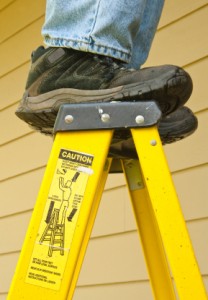 DON’T stand above the second step from the top of a stepladder or the fourth rung from the top of an extension ladder.
DON’T stand above the second step from the top of a stepladder or the fourth rung from the top of an extension ladder.- DON’T climb a closed stepladder.
- DON’T climb on the back of a stepladder.
- DON’T stand or sit on a stepladder top or pail shelf.
- DON’T climb a ladder if you are not physically and mentally up to the task.
- DON’T place the base of an extension ladder too close to or too far away from the building.
- DON’T over-reach, lean to one side or try to move a ladder while on it. Climb down and then reposition the ladder closer to your work.
- DON’T exceed the maximum load capacity or duty rating of a ladder.
- DON’T permit more than one person on a single-sided stepladder or an extension ladder.
Tag: ladder safety
Using Stepladders Safely
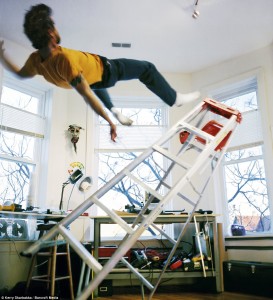 Stepladders range in size from 3 ft. to 20 ft in length along the side rail. Stepladders shorter than 3 ft are considered Step Stools. The highest standing level on a stepladder is slightly more than 2 ft from the top of the ladder. The highest standing level is required to be marked on the specifications label on the side rail of the product. Therefore, when planning your job, the maximum work height is established by adding the user’s height and reach to the highest standing level of the stepladder.
Stepladders range in size from 3 ft. to 20 ft in length along the side rail. Stepladders shorter than 3 ft are considered Step Stools. The highest standing level on a stepladder is slightly more than 2 ft from the top of the ladder. The highest standing level is required to be marked on the specifications label on the side rail of the product. Therefore, when planning your job, the maximum work height is established by adding the user’s height and reach to the highest standing level of the stepladder.
Proper Use
- A Stepladder requires level ground support for all four of its side rails. If this worksite condition does not exist, a stepladder should not be selected for the job.
- A Stepladder must not be used unless its base is spread fully open and the Spreaders locked. Stepladders are not to be used as Single Ladders or in the partially open position.
- In order to prevent tipping the ladder over sideways due to over-reaching, the user must climb or work with the body near the middle of the steps. The ladder should be set-up close to the work. Never attempt to move the ladder without first descending, relocating the ladder, and then re-climbing. Do not attempt to mount the ladder from the side or step from one ladder to another unless the ladder is secured against sideways motion.
- In an effort to avoid losing your balance and falling off the stepladder, the user must not step or stand higher than the step indicated on the label marking the highest standing level. The user must also not step or stand on the Top Cap or bucket/pail shelf.
- When ascending or descending the ladder, always face the ladder and maintain a firm hand hold. Do not attempt to carry other objects in your hand(s) while climbing.
- The braces on the rear of a stepladder are not intended for climbing or standing and must not be used for that purpose. Note, however, that special stepladders are available with steps on both the front and rear and are intended for two users at the same time.
- The anti-slip feet at the bottom of the stepladder side rails must be present and in good condition prior to using the ladder. The ladder must not be used on ice, snow or slippery surfaces unless suitable means to prevent slipping is employed.
- A stepladder must never be placed upon other objects such as boxes, barrels, scaffolds, or other unstable bases in an effort to obtain additional height.
via Stepladders.
Basic Ladder Safety
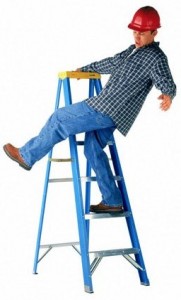 Ladders are tools. Many of the basic safety rules that apply to most tools also apply to the safe use of a ladder:
Ladders are tools. Many of the basic safety rules that apply to most tools also apply to the safe use of a ladder:
- If you feel tired or dizzy, or are prone to losing your balance, stay off the ladder.
- Do not use ladders in high winds or storms.
- Wear clean slip-resistant shoes. Shoes with leather soles are not appropriate for ladder use since they are not considered sufficiently slip-resistant.
- Before using a ladder, inspect it to confirm it is in good working condition.
- Ladders with loose or missing parts must be rejected.
- Rickety ladders that sway or lean to the side must be rejected.
- The ladder you select must be the right size for the job
- The Duty Rating of the ladder must be greater that the total weight of the climber, tools, supplies, and other objects placed upon the ladder.
- The length of the ladder must be sufficient so that the climber does not have to stand on the top rung or step.
- When the ladder is set-up for use, it must be placed on firm level ground and without any type of slippery condition present at either the base or top support points.
- Only one person at a time is permitted on a ladder unless the ladder is specifically designed for more than one climber (such as a Trestle Ladder).
- Ladders must not be placed in front of closed doors that can open toward the ladder. The door must be blocked open, locked, or guarded.
- Read the safety information labels on the ladder.
- The on-product safety information is specific to the particular type of ladder on which it appears. The climber is not considered qualified or adequately trained to use the ladder until familiar with this information.
- Never jump or slide down from a ladder or climb more than one rung/step at a time.
via basic ladder safety.
Minimizing the Risk of Ladder Falls
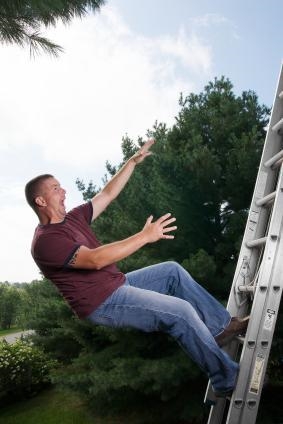 Falls are the leading cause of nonfatal, unintentional injuries, affecting nearly 8 million individuals in 2005, according to the National Safety Council’s “Injury Facts.” Many of these falls involve ladders. Because a ladder is considered a basic tool, some people may discount the dangerous nature of them. However, if proper safety precautions are not taken, ladder users can easily fall and suffer serious injuries or even death. According to the Chicago-based American Ladder Institute, the safest way to climb a ladder to avoid slips or falls is to maintain three points of contact. This means that during both ascent and descent, a climber should have either a hand and two feet, or two hands and one foot, in contact with the ladder at all times. This way, if one hand or foot slips, the climber will still be secure.
Falls are the leading cause of nonfatal, unintentional injuries, affecting nearly 8 million individuals in 2005, according to the National Safety Council’s “Injury Facts.” Many of these falls involve ladders. Because a ladder is considered a basic tool, some people may discount the dangerous nature of them. However, if proper safety precautions are not taken, ladder users can easily fall and suffer serious injuries or even death. According to the Chicago-based American Ladder Institute, the safest way to climb a ladder to avoid slips or falls is to maintain three points of contact. This means that during both ascent and descent, a climber should have either a hand and two feet, or two hands and one foot, in contact with the ladder at all times. This way, if one hand or foot slips, the climber will still be secure.
The following tips can also help minimize the risk of a fall:
- Unless the ladder is specifically designed for such a purpose, do not allow more than one climber on a ladder at one time.
- Never jump or slide down a ladder more than one rung at a time.
- Regularly clean the soles of shoes to maximize traction.
- Use towlines, a tool belt or an assistant to supply materials and tools.
- Climb ladders slowly and deliberately, avoiding sudden movements.
- Climbers should keep the center of the stomach between the ladder side rails when climbing.
- Do not overreach or lean to the side while working, as this could cause the ladder to tip.
Portable Ladder Safety
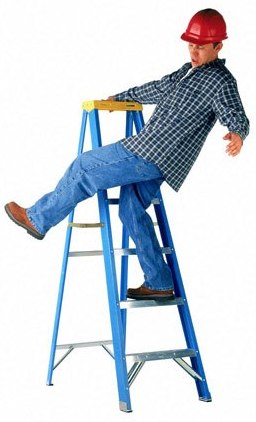 Portable ladders are one of the handiest, simplest tools we use. Because of their effectiveness, ladders are used by many different people to perform many different tasks. Although ladders are very uncomplicated, planning and care are still required to use them safely. Each year in the U.S., accidents involving ladders cause an estimated 300 deaths and 130,000 injuries requiring emergency medical attention.
Portable ladders are one of the handiest, simplest tools we use. Because of their effectiveness, ladders are used by many different people to perform many different tasks. Although ladders are very uncomplicated, planning and care are still required to use them safely. Each year in the U.S., accidents involving ladders cause an estimated 300 deaths and 130,000 injuries requiring emergency medical attention.
via G1932 Portable Ladder Safety | University of Missouri Extension.
